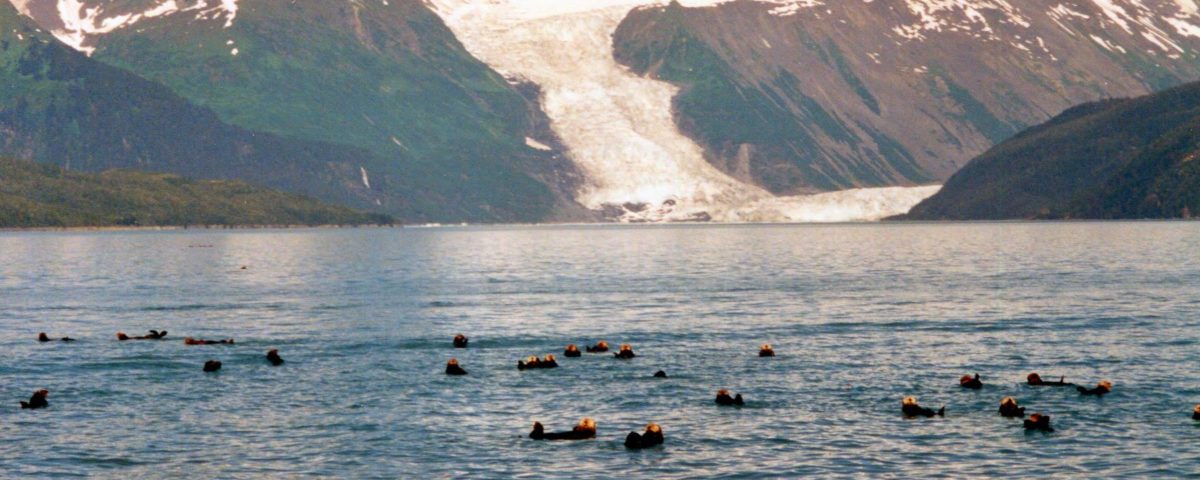Otters of Alaska

By Cristina Reo
April is Otter Month at the Prince William Sound Science Center. There are 13 different species of otters found across the world. Otters are found on almost every continent, with the exception of Australia and Antarctica. We can find two of these species here in Alaska: the northern river otter (Lontra canadensis) and the sea otter (Enhydra lutris). Otters are carnivorous mammals that can be found in oceans, rivers, lakes, and swamps. They are semi-aquatic, meaning they spend some of their lives in water and some on land. Otters have webbed feet for swimming and dense fur to keep them warm. They have a special adaptation that allows them to close their ears and nose while swimming.
The northern river otter (also known as North American river otter) weighs an average of 22 pounds and has an average lifespan of 12 years. They have muscular and slender bodies with short legs and a muscular, long tail. They have a brown to gray fur coloration with cream underbellies. They can be found in lakes, streams, marshes, and rivers from the Rio Grande to northern Alaska. The northern river otter has a diverse diet that consists of fish, insects, small mammals, amphibians, and small reptiles like turtles. Generally, river otters are found alone or in pairs. They are sociable creatures and can be seen socializing and playing with others. The North American river otter gives birth to their young in March or April, in a den where the pups will stay until they are around two months old. After they come out of the den, the pups learn how to swim. The family stays together for about 7-8 months.
The sea otter weighs an average of 60 pounds. They have short faces, retractable claws, the densest fur of any mammal. Flaps under their forearm are used for storage of things like rocks – that they use as tools – and food. They are dark brown in coloration with lighter brown to cream colored faces. Sea otters have a lifespan of up to 23 years. They can be found along the Pacific Coast from California to Alaska. Their diet consists mainly of invertebrates: sea urchins, sea stars, octopuses, mussels, etc. They are polygynous, meaning they will have multiple mates. Sea otters are only capable of giving birth to one pup at a time and will care for it for 5-6 months. The father does not help in raising the pup.
While we only have two species of otters in North America, there are 11 other species across the world. The Eurasian otter, (Lutra lutra) is found all throughout Eurasia and parts of Northern Africa. The hairy-nosed otter (Lutra sumatrana) can be found in southeast Asia. The spotted-necked otter (Hydrictus maculicollis) is found in sub-Saharan and southeastern African countries. The smooth-coated otter (Lutrogale perspicillata) is found in India, southeast Asia, and China. The South American river otter (Lontra provocax) is found in South America. The neotropical river otter (Lontra longicaudis) is found in Mexico and South America. The marine otter (Lontra felina) is found along the South American Pacific Coast and is the only species of river otter known to spend a majority of its time in salt water. The giant otter (Pteronura brasiliensis) is found in South America and can weigh up to 75 pounds. The Asian small-clawed otter (Amblonyx cinereus) is found in southern India, China, Asia, and into the Philippines. The African clawless otter (Aonyx capensis) is found in western and southern Africa. Finally, the Congo clawless otter (Aonyx congicus) can be found in Africa.
We hope you celebrate Otter Month with us and learn about these furry mammals that call Alaska home. Follow along with our social media channels all month long to learn some fun facts about otters.
Photo: Sea otters with Cascade and Barry Glaciers in the background, Prince William Sound. Photo by Signe Baumann.



